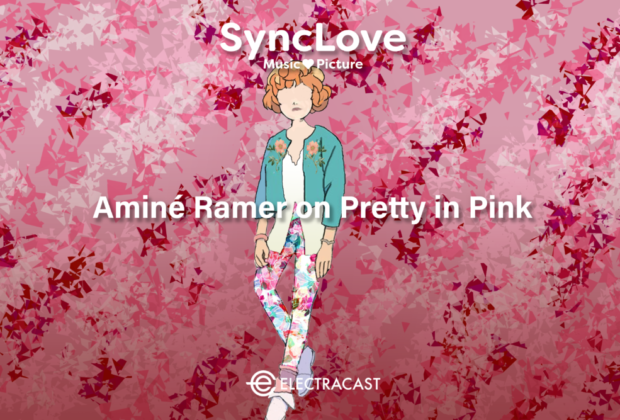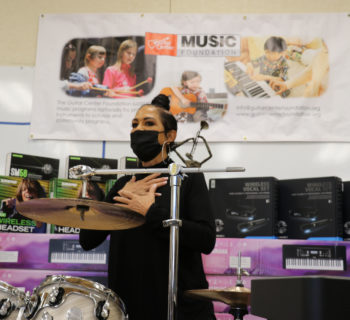SyncLove is a new channel from commercial music licensing platform SyncFloor that sees production professionals dive into their favorite moments in films and the scenes that changed the way they thought about music for picture.
Seasoned music supervisor Aminé Ramer really didn’t want to go there, but she did: sharing her thoughts on Pretty in Pink and its classic soundtrack. Ramer joins SyncLove’s host Kirt Debique, CEO and co-founder of SyncFloor, for the latest episode of SyncLove.
What the film may lack in arthouse mystique, it more than makes up for in generational impact. Some of us remember being shaped by films like Pretty in Pink, one of a string of iconic 80s and 90s movies that featured memorable post-punk-meets-vintage-cool soundtracks. The pitch-perfect placement of key songs from the era, from OMD’s “If You Leave” and New Order’s “Shellshock” to The Smiths’ “Please Please Please,” brought what could have been a cookie-cutter teen tale to quirky, brilliant life. You may not remember the storyline, but you probably can hum the film’s namesake song by the Psychedelic Furs, if you’re of a certain age.
Beyond the stickiness, taste, and focus of the film’s soundtrack, however, Ramer points to the film crew’s commitment to crafting songs just for the story, a process that started before the first scene was shot. “It's such an inspiration,” she notes. “Not only was the music taken so seriously, as such an important part of the film, but they started making the songs before the film. That they actually put the time and effort and thought into getting the right songs, getting songs made, is amazing.”
This attention to craft and commitment to sourcing the right song run through Ramer’s own work. When she begins working on a project, “It's always an emotional place that I start out with. What is it that we're trying to say? What is it we want the audience to feel, and then going, what are our options within that palette?”
Ramer has worked as a music supervisor for both big-budget films and important but shoe-string projects chronicling key moments in culture and politics, including Flint Town and Crip Camp. She talks about her balance between the projects with bigger paychecks and the projects that feed the soul, about “the feels and the reals.” Yet even on the most commercial project, Ramer focuses on what the music is saying and how music can enhance our understanding of a character or person in a film. “There are all these different angles that music can convey and the importance of it, whether it's score or a song: what are you saying? What emotion, what tone, what message are you saying with the music? And sometimes it's sitting in the background because it doesn't need to be elevated.”
Ramer’s also more than willing to do the legwork to find just the right tracks and to make sure they capture the color of the time and setting of the film. She tells the tale of finding the perfect song from the 1960s, then corresponding with the elder songwriter on paper via snail mail to secure the rights. She sought out the right, era-appropriate songs for Crip Camp, landing on the striking original version of “Like a Ship,” a track that transforms its moment in the film.
For Ramer, this work is part and parcel of her role as a music supervisor. “As the supervisor, part of your job is to be an advocate for the project, even if it is the producer and the director's vision. If you're looking at a scene, you have to come at it with, ‘Okay, what would work best in this project taking into account what they want?’,...what your budget is, all of these factors,” Ramer says. You need to “actually go big picture and try to communicate those things in a way that can actually be heard,” even if you have to push back against a director or showrunner’s dream ditty, or seek out a local artist in his golden years.This focus on what’s best for a project is ultimately what drew Ramer to dive into Pretty in Pink. It didn’t matter if an OMD song played for what can feel like endless minutes at the final school dance scene, an ending they had to reshoot after audiences rebelled, or if a whole scene revolved around an Otis Redding classic. John Hughes and his team went for what worked, even if it seemed strange. They brought music into the conversation early—and shaped the sound of a generation that way. “It’s such a beautiful example of the collaboration that must've occurred between the filmmakers, the musicians, the bands, even the label who's deciding to put out the soundtrack,” Ramer muses. This kind of collaboration and a tireless dedication to craft, for Ramer, form the heart of music supervision at its best.
SyncLove is sponsored by SyncFloor, where you can find inspiring music by real artists.
Check out the podcast episode on SyncLove HERE.
SyncLove is sponsored by SyncFloor, where you can find inspiring music by real artists.
Want music that feels like Pretty in Pink in your next production?














